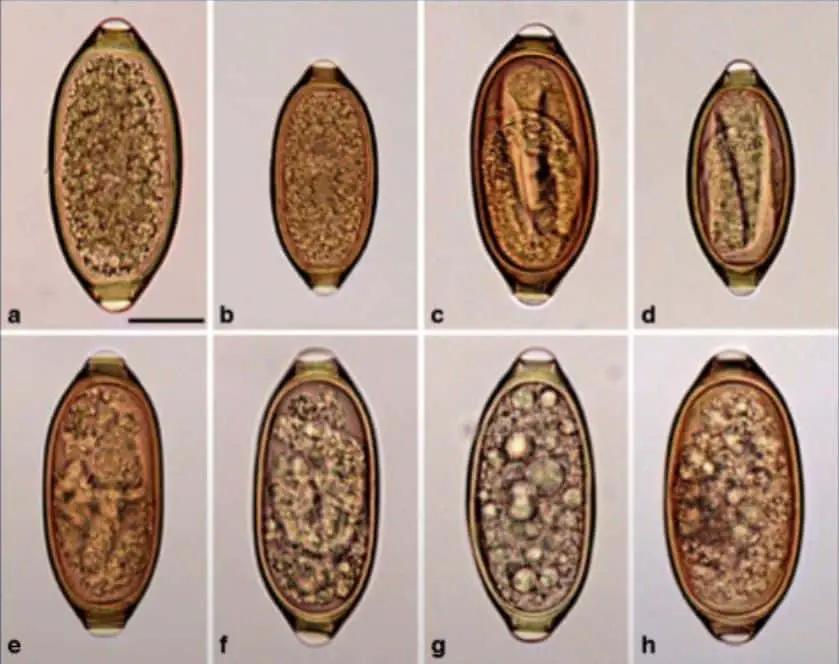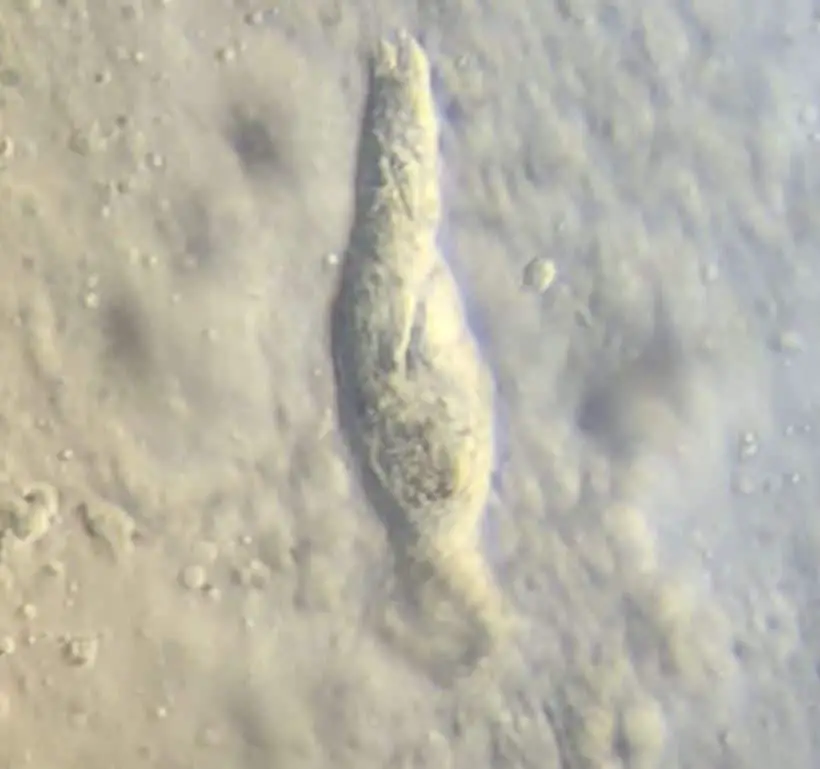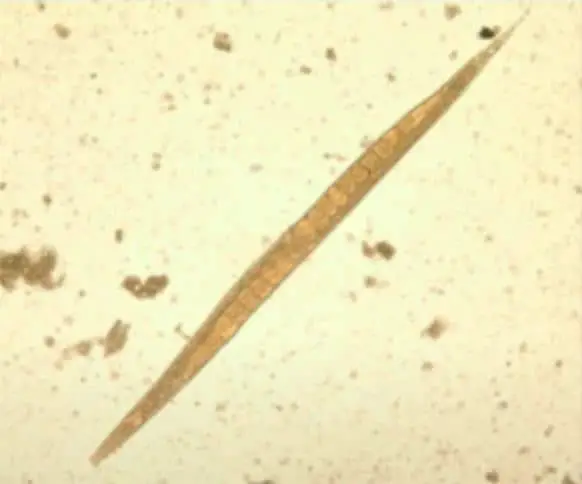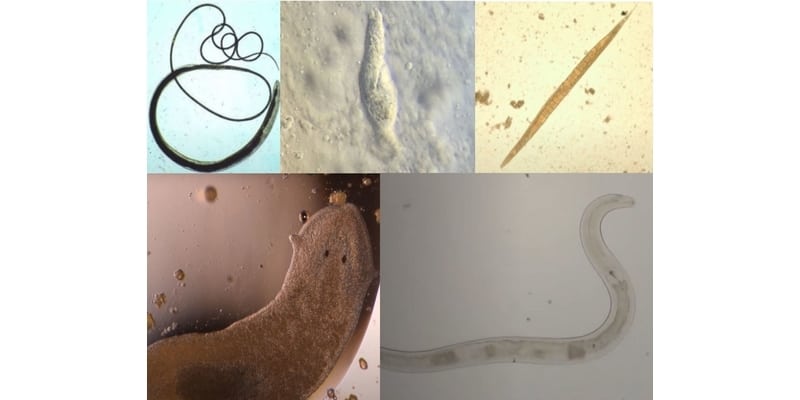There are an estimated one trillion species of microbes on earth with over 99.99% of the species yet to be discovered. Amongst the discovered species are parasitic worms called Helminths.
Helminths are free-feeding parasitic worms that invade a host to obtain nutrients and protection. Helminths can be broken down into four major groups: flatworms, tapeworms, roundworms, and flukes. They are microscopic in a larval phase but can grow to sizes that can be seen with the naked eye.
The microscopic world has a lot to offer in terms of expanding our understanding of the natural world and our history as living beings. Other benefits of studying microorganisms extend to advances in the medical field, agriculture, and more.
Common Types of Helminths?

It’s estimated that there are over 300,000 species of Helminths that infect vertebrates. Of those 300,000, there are approximately 300 species that invade humans as a host. Let’s take a look at some of the most well-known Helminths in the world today:
- Ascaris lumbricoides: Otherwise known as the ‘Giant Roundworm’, this species infects humans and can grow up to 14 inches in length. It’s within the phylum Nematoda and is the most common parasitic worm in humans in the world. It is responsible for the disease ascariasis, which is a form of helminthiasis that causes malnutrition, anemia, and more. An estimated one billion people are infected with this species on a yearly basis, mostly in Africa, China, and eastern Asia. Its eggs are highly resistant to chemicals and can remain viable in soils for multiple years.
- Ancylostoma caninum: This is a species of hookworm that is famous for infecting the small intestines of dogs. It may be asymptomatic and go unnoticed until the dog dies. A vaccine is available, but infection is mostly kept away from proper nourishment and exercise. Much like most other Helminth infections, this hookworm is most common in temperate, tropical, and subtropical regions. Adults may grow up to .63 inches which means that they are visible to the naked eye.
- Taenia solium: Otherwise known as the ‘Pork Tapeworm’, this is a species of flatworm that is most common are areas where pork is eaten. It uses pigs as a secondary host to ultimately infect humans as the primary host. It’s transmitted to and from pigs via feces which contaminates the food sources. Consumption of undercooked and uncooked pork ultimately leads to infection. The adult tapeworm can grow up to 3 meters long. Symptoms of infection include diseases such as taeniasis and cysticercosis, which lead to dementia and hypertension. Pork Tapeworm are responsible for epilepsy and other neurological disorders in humans.
- Fasciola hepatica: Also known as the ‘Common Liver Fluke’ or the ‘Sheep Liver Fluke’, this is a parasitic trematode that infects the liver of a variety of mammals including humans. It’s transmitted commonly to and from sheep and cattle throughout the world. An infection causes a disease called fasciolosis, which is a type of helminthiasis that causes fever, abdominal pain, malaise, gastrointestinal issues, anemia, jaundice, respiratory issues, and much more. Up to half of those infected do not experience any symptoms. This species is singlehandedly responsible for great economic losses for livestock of countries as it has wiped out entire herds of cattle or sheep. This is proof that Helminths are not only detrimental to human health, but also to the economy.
Where do Helminths live?
Many species of Helminths live within the soil. Soil-transmitted helminths are most commonly whipworms and hookworms. Approximately one billion humans are infected with Ascaris, approximately 800 million are infected with whipworm, and approximately 745 million are infected with a hookworm.
These parasitic worms are mainly found in warm areas with moist climates. The areas where these parasitic worms are commonly found also have poor hygiene and sanitization practices. Temperate zones also have issues with soil-transmitted helminths during the warmer months.
Because of their prevalence, Helminths are categorized by the Center for Disease Control and Prevention as Neglected Tropical Diseases (NTD) since they are incredibly detrimental yet can be easily controlled and eliminated.
Soil-transmitted Helminths live most of their lives in the intestines. As the host defecates outside, perhaps into a nearby bush, garden, or field, the worm and its larva persist. Feces is oftentimes used as a fertilizer which, may in turn, infect fruits and vegetables that are later eaten by humans.
Ascaris and hookworm eggs mature in soil. Infections occur when people’s hands or fingers come in contact with infected soil. This happens during gardening or when people are consuming fruits or vegetables that have not been adequately washed or cooked. Hookworm eggs are not ineffective and hatch in the soil which releases larvae. These larvae can actually penetrate the skin of humans and infiltrate the host in that manner. Hookworms are transmitted through the soil mainly by walking barefoot over contaminated soils.
Within the human body, Helminths live within the digestive system. Most species of Helminths are intestinal, meaning that they spend their lives within the large or small intestines of living creatures. Other Helminths may live within the stomach or other digestive organs. Most Helminths make their way down to the intestines where eggs are laid close to the anus.

Eggs are strategically laid near the anus. When larvae hatch, they create an itching sensation in the host. The host is inclined to itch his or her anus and spread the larvae to a new host through physical contact.
Filarial worms are a type of roundworm that are transmitted via mosquito bites. They live in the lymph nodes causing lymphatic filariasis. Lymphatic filariasis is a painful and profound disease that results in swelling and impacts fluid retention in the limbs and genitalia. It also lives in the fat layer of the skin which can cause onchocerciasis which is known as river blindness since it can lead to blindness.
Tissue flukes are another kind of parasitic worm that lives within the bile ducts of humans and feeds on epithelial cells there. They may live in tissues of other organs but mainly cause issues with blocking and swelling of the bile ducts, which carries bile from the liver to the intestine to aid in digestion. Blood flukes spend the main stages of their life cycle directly within the blood of the host. It’s mainly a tropical infection that comes from bathing in freshwater that is contaminated with the larva. In chronic infections, eggs have become lodged in the bladder, intestine, lungs, liver, and even the brain. If left untreated, blood flukes can be fatal.
What do Helminths Eat?

There are approximately 3,000 species of flatworms that all have their own unique diet. For the most part, flatworms feed on protozoa, bacteria, and even smaller worms. They consume food that is either dead or alive which means that they may be detritivorous in nature as primary decomposers. Larval flatworms may eat plants or algae until they are large enough to feed on animal matter. Fully grown flatworms may eat other creatures as large as snails and bivalves. Their flat bodies allow them to slip into the shells and eat the host. Flatworms, like many Helminths, use antennae-like projections to locate prey.
Tapeworms are free-feeding but may attach themselves to the lining of the host’s small intestine. Tapeworms use an arrangement of suckers and possibly even hooks (depending on the species) to attach themselves to the intestinal lining. Once the tapeworm is anchored, the host’s digestive material flows over it. Tapeworm mainly absorbs nutrients through its skin as the digestive material flows by. If it steals too many nutrients from the host, then the host may start experiencing side effects.
Roundworms are mainly predatory carnivores that have teeth to feed on organic material. They may have a long, spear-like structure to stab and suck the nutrients out of their prey. Nematodes mainly feed on organic matter, both dead and alive. They also feed on diatoms, algae, fungi, and bacteria. Some eat plants. When they infect humans, roundworms excrete a chemical that prevents the host from adequately digesting nutrients. The roundworm then feeds off the nutrient-rich intestinal fluid, blood, mucus, and tissue. Flukes prefer to feed off their host’s blood. They use blood-sucking structures to pump out blood from the host and feed on the nutrients within. They eat blood cells, mucus, and even cells from the body.
Are Helminths Dangerous to Humans?

The CDC reports that anywhere from 807 to 1,121 million humans are infected with Ascaris. Approximately 604 to 795 million are infected with whipworm. Approximately 576-740 million are infected with hookworm. These staggering numbers certainly do come with their consequences if left untreated.
One of the deadliest Helminths is the Halicephalobus gingivalis, which is a free-living and soil-transmitted nematode. It is generally harmless but has recently been linked to neurological diseases in horses. Human infection is thankfully rare but tends to impact individuals with compromised immune systems. It causes inflammation of the brain, spinal cord, and their associated membranes. It’s usually not discovered by medical teams until the host is deceased.
The Taenia solium, also known as the ‘Pork tapeworm’, is linked to epileptic seizures and many of the neurological problems in humans. The tapeworm freely enters and exits the host’s bloodstream and lays eggs along the way. In rare occurrences, the larvae will cross into the blood-brain barrier of the central nervous system and cause neurocysticercosis, which causes seizures. This tapeworm is prevalent in South American and sub-Saharan countries but is nearly nonexistent in Western cultures like the United States.
The Cryptostrongylus pulmonic is also referred to as the ‘Hidden Lung Worm’. It’s a microscopic roundworm that is found in the blood of its host. The lung worm secretes biological molecules which are detrimental to brain function. This Helminth often lives unnoticed and can cause chronic fatigue syndrome along with brain damage.
Spirometra erinaceieuropae is a rather rare species of tapeworm that lives mainly in amphibians and crustaceans. It’s also found in cats and dogs as adults. Humans tend to be accidental hosts for this species, but infections are known to cause sparganosis. Infections lead to headaches, seizures, and memory loss. Infection occurs by drinking water that contains infected crustaceans. Infections cause large nodules below the skin and swelling of the muscles that control eye movement. While brain infections are unlikely and rare, they are often detrimental.
In 2013, there were over one million documented deaths caused by parasites. Many of those deaths were caused by Helminths. Hookworm infection led to over 200,000 deaths. The good news is that Helminth infections are easily treated. Most symptoms are mild and may even go unnoticed. Many symptoms range from upset stomachs to flu-like symptoms and headaches. Helminth infections are easily treated, and recovery is likely if identified early. Western cultures like the United States do not suffer from Helminth infections as hygiene and sanitation practices are effective in killing larva.
Life Cycle of Helminths
Helminths live through three main life-cycle stages: egg stage, larvae stage, and adult stage. Adult worms ultimately infect the hosts and do the most damage. Larval stages tend to be free-living. Larvae of Helminths undergo four main metamorphoses before they reach adulthood. In the egg stage, Helminths release six hooked embryos why are then ingested by intermediate hosts until they hatch.
Flukes have more complex life cycles as the larva undergo asexual amplification in some intermediate hosts. The eggs hatch and let out free-swimming miracidia which swim around and infect snails and then multiply. Flukes commonly have about seven different stages of their lifecycle.
A typical nematode lifecycle goes from egg to larvae to adult. A typical cestode lifecycle goes from egg to metacestode to adult. A typical fluke lifecycle goes from egg to miracidium to sporocyst to redia to cercaria to adult.
Helminths are transmitted from host to environment and vice versa in mainly four different ways:
- Fecal-oral transmission: Eggs are larvae and excreted from a host. The excreted eggs or larva do not grow until ingested by a new host. They are transmitted via water or soil.
- Transdermal transmission: The ineffective larvae live in the soil and actively penetrates through the skin when in contact with a host. This is common in hookworms and leads to iron deficiency and ultimately anemia.
- Vector-borne transmission: Larvae are often transmitted by blood-sucking arthropods. Other common carriers include mosquitos.
- Predator-prey transmission: Larvae are transmitted when a predator feasts on a prey. The prey often acts are a secondary host while the Helminth matures once inside of the predator, or the primary host.
Although the method of transmission varies, most species of Helminth are found in warm and moist climates. There are not many species of Helminth that are capable of persisting in extreme climates such as cold temperatures, dry environments, or highly saline environments. The lifecycle of Helminths can vary from days to years. The longest recorded life span of a tapeworm was 35 years. In that time, the creature grew up to 108 feet.
Most adult helminths will persist until their host deceases, meaning that lifespan of Helminth varies greatly, especially from species to species. Deerflies have been known to infect deer or humans with adult worms that live up to 17 years in the body and are actively reproducing throughout their entire lifespan.
The History of Helminths
The rich history of Helminths dates to Egyptian culture in 1550 B.C. An ancient manuscript was uncovered on hieroglyphics within a tomb in the Nile Valley that was unearthed in 1872. The manuscript contained medical facts and observations of parasitic worms, which are now known as Helminths.
The manuscript contained recipes, remedies, and treatments for parasitic worm infections that plagued the early Egyptian cultures. Back then, the priesthood was responsible for healing. There were three types of priests that would have been responsible for treating Helminth infections: the surgeon-priest, the spell priest, and the botanist priest.
The surgeon-priest was responsible for wounds, fractures, and even brain surgeries. The spell priests used spells, potions, and prayers, to heal the sick. The botanist priest was semireligious and used herbs and other remedies to cure illnesses and pains amongst their patients. Each type of priest had its own remedy for the common complaints associated with a parasitic worm infection.
Two intestinal Helminths were the focus of the uncovered manuscript: the roundworm and the tapeworm. The manuscript consisted of 32 recipes that could be used to expel a parasitic worm from the belly of the infected. Ingredients included pomegranate roots, malachite, dates, and even goose fat. Most of the recipes were to be washed down with a ‘sweet beer’, which probably helped with the pain.
A rather large portion of the manuscript was dedicated to treating hematuria (blood in the urine), which is a well-known effect of a parasitic worm infection. Egyptian priests originally believed that hematuria was caused by ‘a god or dead man in the belly of a man’. They believed that the worms were a result of hematuria. It wasn’t until 1851 that a Cairo native demonstrated that the worms caused hematuria, not the other way around.
At the end of the manuscript, there is a short section about how to surgically remove parasitic worms. The manuscript talks about using a knife to make an incision and then forceps to grab hold of the worm. The worm is to be pulled out with special care to not damage the flesh. It’s thought that the manuscript was specifically alluding to the Guinea worm. Even today, the preferred method of treatment for the Guinea worm is by removal via surgery.
The Bible made the next known reference to Helminths. In the story of Moses, a religious prophet leads his people out of Egypt and to a holy land. Traveling tribes were known to have issues with parasitic worms. This is thought to be from drinking contaminated water throughout the journey. The Bible says that Moses warned his people from drinking ‘infected water’ with ‘cupped hands’.
The Old Testament of the Bible speaks of ‘fiery serpents’ that were to be ‘put upon poles’. It’s thought that the dreaded Guinea worm was the fiery serpent in question. This is mainly because Israelites frequently stopped to bathe in stagnant water where the Guinea worm was prevalent.
Fast forward to the fifth century of ancient Greek history. Hippocrates lived around 460-377 B.C. Hippocrates is often referred to as the ‘father of medical science’. His modern fame stems from this literary collection. Within this collection is a surgical section that details the removal of hydatid cysts that plagued the Greeks. Other entries include excerpts about the breeding habits of the roundworm and flatworm. Hippocrates wrote about ‘watermelon seeds’ within human feces which were later linked to tapeworms shedding proglottids.
Pliny, another Greek writer, was the first to document the size of Helminths. He wrote that the flatworm, which he named Taenia, could reach a length of up to thirty feet within the bowels of a man. Pliny wrote about straightening out and measuring a tapeworm that was extracted from a man.
Parasitic infections were also prevalent in ancient Chinese culture. Not much progress was made medicinally until a Chinese physician hypothesized that, “some people become parasitized by worms through eating fruits and vegetables or animals’ viscera, which contain their progeny.” This warning wasn’t headed until four centuries later when this theory was confirmed.
A Persian physician who lives from 980-1037 A.D. described four kinds of Helminths. The first he described as ‘pumpkin seeds’, which were attributed to eating raw beef and caused itching in the anus. Parasitic worms plagued mostly all cultures throughout the ages up until Leeuwenhoek invented microscopes back in the 1600s. Marcello Malpighi became a founding father in microscopy as it relates to Helminths at this time. His research allowed medical professionals to better understand the egg, larval, and adult stages of Helminths which finally led to effective treatments.
References
- https://www.yourgenome.org/facts/what-are-helminths
- https://www-jstor-org.ezproxy.lib.utah.edu/stable/20278?seq=8#metadata_info_tab_contents
- https://www.ncbi.nlm.nih.gov/books/NBK8282/#_A4547_
- https://courses.lumenlearning.com/boundless-microbiology/chapter/helminths/
- https://parasite.org.au/para-site/contents/helminth-intoduction.html
- https://theconversation.com/five-deadly-parasites-that-have-crossed-the-globe-35944
- https://my.clevelandclinic.org/health/diseases/15240-roundworms
- https://www.cdc.gov/parasites/loiasis/disease.html#:~:text=Adult%20worms%20may%20live%20up,for%20much%20of%20this%20time.

